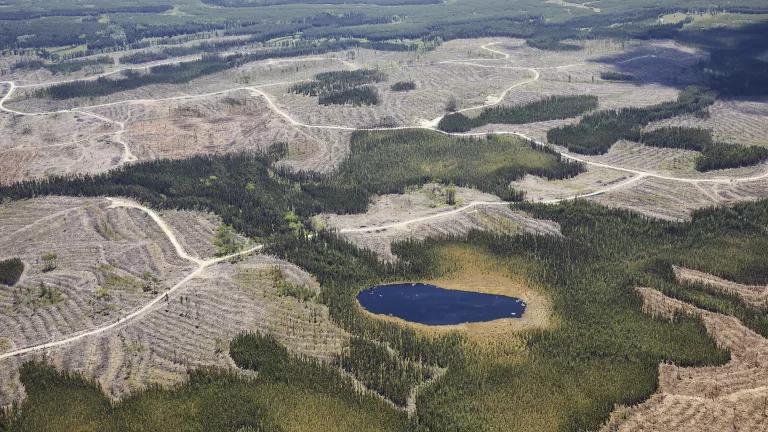Let’s Protect More Wetlands with FEMA Funds
NRDC’s new report underscores the importance of wetlands to the health of our planet, its people, and its wildlife.

Mangroves and sandbars along the western coastline of Tampa Bay, Florida
Getty Images
NRDC released a new report today underscoring the importance of wetlands to the health of our planet, its people, and its wildlife. Readers who love wetlands as much as I do might already be familiar with the climate and biodiversity benefits described in the report. What might surprise you, however, is that the Federal Emergency Management Agency (FEMA)—not the first federal agency that typically leaps to mind when it comes to conservation policy—has a big role to play in meeting our wetland protection goals.
Wetlands keep us safe from disasters
Why should FEMA, best known for helping communities recover after natural disasters, care about wetlands? Because wetlands help protect people and property from harm, reducing the amount of damage that disasters inflict in the first place.
As our new report describes, coastal wetlands, like salt marshes and mangrove forests, mitigate flood risk and protect against storm surges. They can reduce wave heights by more than 70 percent, preventing the destruction of nearby buildings and infrastructure. Riverine wetlands also provide big-time flood protection benefits: Floodplains and riparian buffers along inland waterways absorb floodwaters that would otherwise inundate nearby communities.
What about when there’s too little water rather than too much? Wetlands have us covered there, too. They store and gradually release water downstream, helping to regulate water supplies during dry periods and boosting the drought resilience of surrounding communities.
FEMA grants can support wetlands—but they’re falling short
As our nation’s foremost supporter of emergency preparedness efforts, FEMA has recognized that wetlands protection—along with other “nature-based solutions” to natural hazard mitigation—is critical to the agency’s mission. And the agency has a powerful tool at its disposal: its large and still-growing Building Resilient Infrastructure and Communities (BRIC) grant program.
BRIC grants support community projects to reduce the risk of harm from disasters before they happen. They fund all kinds of resilience-building efforts, from planning initiatives to public infrastructure projects. FEMA announced that it planned to distribute more than $2 billion through the BRIC program in federal fiscal year 2022.
The agency has stated that incorporating nature-based solutions like wetland conservation and restoration is one of its priorities in administering these grants. Yet an NRDC analysis found that in the most recent round of funding, fewer than 40 percent of projects included any nature-based elements at all, a lower percentage than the previous year. And while some of those projects had nature-based solutions at their core, others were multipart projects with minimal nature-based components.



Clockwise from top left: Volunteers restore habitat along California's coastline wetland marshes; a green heron in a wetland marsh in the South Padre Island Birding Center in Texas; a project to rebuild sand dunes around Zuma Beach and Point Dume in California
Yelena Kulikova/Contributor, Getty Images
; 2)VW Pics/Contributor, Getty Images
; 3)Al Seib/Los Angeles Times via Getty Images
FEMA should update BRIC policies to create better incentives for wetland projects
It’s clear that the BRIC program isn’t meeting its full potential when it comes to supporting wetlands, which is a shame, considering the opportunity presented by the availability of these funds. The good news is that a few key policy changes by FEMA could make a huge difference:
- FEMA should create a mandatory 20 percent minimum set-aside within BRIC for nature-based projects such as wetlands conservation and restoration. Setting aside a dedicated pot of funding would increase the number of applications, ensure that resources are always available for these critical projects, and avoid the need for nature-based applications to compete against the general pool of applicants.
- FEMA should revise the BRIC scoring criteria to better prioritize nature-based projects. The current criteria provide only 10 points to such projects, out of a possible 115 points. That’s too low to give them a meaningful advantage in the scoring process. Also, FEMA uses an “all or nothing” approach to scoring: All applications that incorporate nature-based elements receive the same 10 points, regardless of the scale or scope of those components. This low bar means there’s no incentive to do more than the minimum necessary to earn those 10 points. To create a stronger incentive structure, FEMA should adopt a tiered point system so that projects incorporating more extensive nature-based components will receive more points.
- FEMA should reduce cost-benefit analysis hurdles for nature-based projects. Because of the inherent difficulty of quantifying ecosystem benefits, wetland protection and other nature-based projects tend to face challenges competing against traditional infrastructure projects in a cost-benefit analysis. To address this obstacle, FEMA should broaden the kinds of ecological and social benefits considered, beyond what’s allowed under the current ecosystem services benefits policy. FEMA should also complete studies of nature-based project benefits that project applicants can refer to without having to complete their own analysis.
- FEMA should support capacity-building activities for local governments. Communities need more capacity to understand the efficacy and funding eligibility of nature-based approaches and to design, plan, and implement projects. FEMA should make capacity-building activities eligible for BRIC funding, create a dedicated set-aside for these activities, and incentivize them through its scoring and cost-share policies.
- Finally, FEMA should improve data availability and transparency around nature-based projects. FEMA data currently don’t provide information about how much BRIC funding is supporting nature-based solutions, primarily due to the “all or nothing” approach to project categorization described above. FEMA should compile and publicly share details on the nature-based elements of each BRIC-funded project, including the proportion of the overall project cost that supports nature-based solutions like wetland protection.
NRDC has already reached out to FEMA to request that it make these changes, and we’re waiting to hear back. We look forward to working with the agency to significantly expand its support for beneficial wetland conservation and restoration projects across the country.






